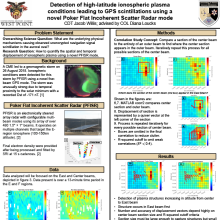Detection of the apparent motion of high-latitude ionospheric plasma leading to GPS scintillations using a novel Poker Flat Incoherent Scatter Radar mode and supporting all sky imagery.
Jacob
Willis
United States Military Academy
Poster
The Poker Flat Research Range located in Fairbanks, Alaska, provides data on ionospheric conditions. The Poker Flat Incoherent Scatter Radar (PFISR) detects plasma densities along the line of sight of conjunctive GPS signals in the E and F regions of the ionosphere through a novel mode using five independent radar beams. All Sky imagery detects narrow band electron precipitation in a wide field of view. This research project analyzes data collected on August 26, 2018 from PFISR and all sky imagery to show how plasma structures displace both spatially and temporally. Cross-correlation methods in this study compare electron densities reported along each of five PFISR beams to detect when and where plasma structure patterns reoccur. The PFISR statistical analysis is then compared to apparent auroral motion captured by 557.7 nm all sky imagery. The three-dimensional characterization of apparent auroral motion captured by PFISR is within an order of magnitude of the two-dimensional apparent auroral motion captured by all sky imagery. Initial results indicate that this analysis technique can successfully be applied across data spanning four Arctic winters. This study has the potential to quantify the three-dimensional auroral motion within the ionosphere and enhance the utility of ISRs in detecting GPS scintillation.

Poster PDF
Poster category
Ionosphere and Thermosphere Research and Applications
Meeting homepage